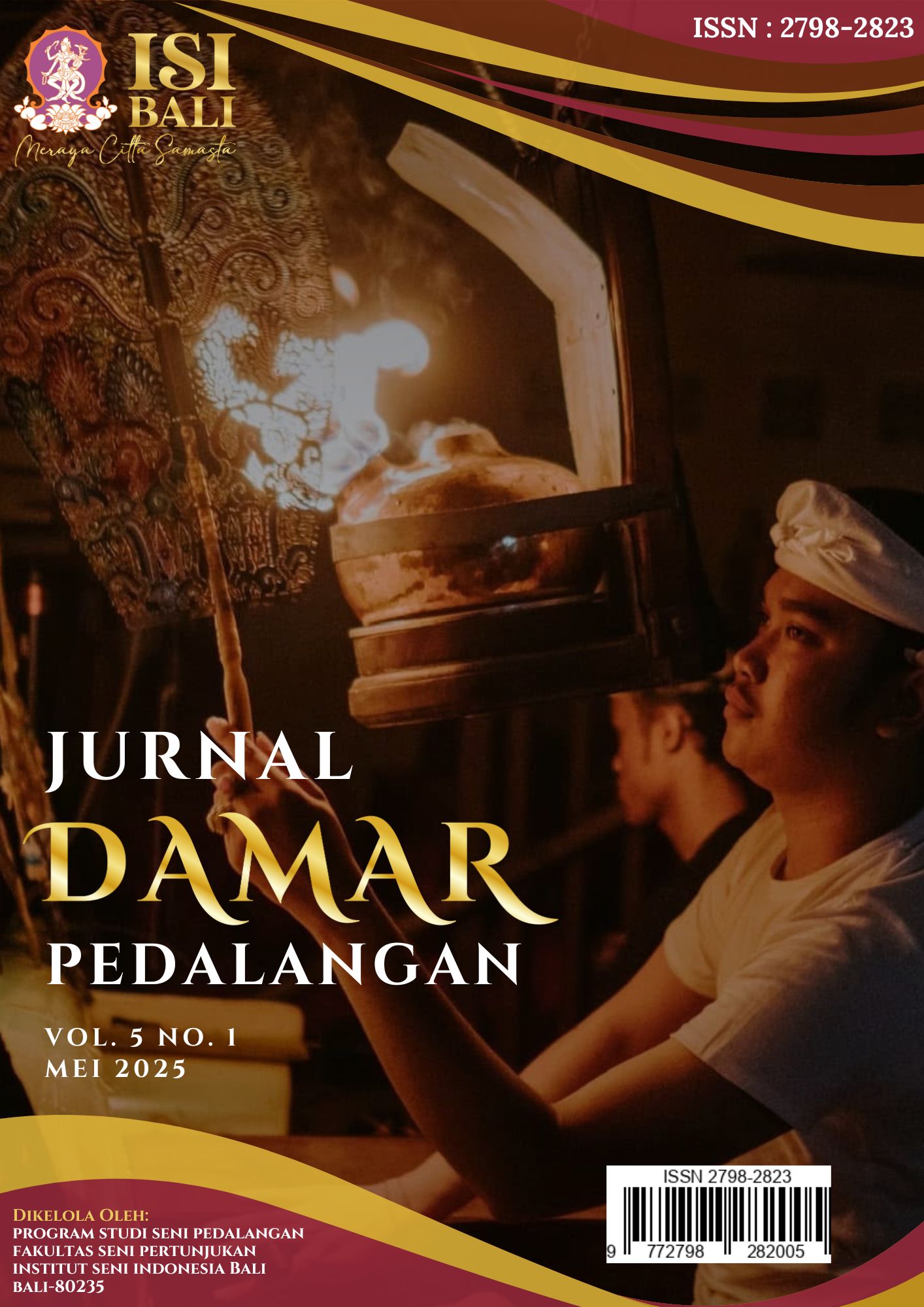KAJIAN UNSUR DRAMATIK DAN ESTETIKA TAMAN PENASAR CERAKEN
DOI:
https://doi.org/10.59997/dmr.v5i1.4880Keywords:
Dramatic Structur , Aesthetic Elements, Taman Penasar CerakenAbstract
Taman Penasar is an artistic development derived from Pasantian, which integrates vocal performance, literature, acting, and traditional music played by 5-7 core performers. This performance serves not only as entertainment but also as a guide for social interaction. Unfortunately, despite its profound cultural values, it has received limited academic attention, such as the Taman Penasar performance titled Ceraken, which presents issues surrounding traditional Balinese medicine and the role of Balian (traditional healers), a topic of current discussion. This study aims to analyze the dramatic structure, aesthetic elements, and inherent values of the performance. A qualitative approach is used to descriptively present the findings, employing drama theory and aesthetic theory as analytical tools. The results of this study show that the dramatic elements of the performance are constructed through: 1) A plot based on contemporary societal issues; 2) A forward-moving narrative structure; 3) Characterization through new terms introduced in the performance, such as Panegteg, Panungkas, Panembang, and Paneges; 4) Setting conveyed through dialogue; 5) Dialogue that upholds the ethical use of the Balinese language. The aesthetic elements are built through the performance's integrity, emotional depth, harmony in costumes and movement, and the prominence of tembang (traditional songs), musical accompaniment, and acting. Additionally, the balance between tembang, musical accompaniment, Paneges, Panegteg, and Panungkas is emphasized. This performance also upholds religious, social, and educational values. Therefore, the researcher hopes that this performance will continue to thrive and attract public interest as a valuable medium for learning.
Downloads
References
[1] A. Santika, “Signifikasi peran antagonis dalam pementasan taman penasar kota denpasar tahun 2023,” jurnal damar, vol. III, no. 2, pp. 97-103, 2023.
[2] I. K. Sudirga, Kebangkitan Pesantian Di Bali Pada Era Globalisasi, Denpasar: Program Pascasarjana Universitas Udayana, 2012.
[3] N. N. Karmini, Teori & Apresiasi Drama, Denpasar : Pustaka Larasan , 2022.
[4] P. D. H. J. Waluyo, Drama Teori dan Pengajarannya, Yogyakarta : Hanindita Graha Widia, 2001.
[5] D. A. A. M. Djelantik, Estetika Sebuah Pengantar, Bandung: Masyarakat Seni Pertunjukan , 1999.
[6] I. W. Bandem, Wimba Tembang Macapat, Denpasar: BP Stikom Bali , 2009.
[7] N. K. D. Yulianti, “The Aesthetic Value of the Accompaniment Music of the Dance Drama 'The Blessing of Siva-Visvapujita' | Nilai Estetika Musik Iringan Drama Tari “The Blessing of Siva-Visvapujita”,” Ghurnita, vol. 4, no. 3, pp. 265-272, 2024.
[8] H. M. Qomar, Metodelogi Penelitian Kualitatif, Malang: Intelegensia Media, 2022.
[9] E. T. Khairally, “Saput Poleng (kain poleng) Bali : sejarah dan fungsinya,” 22 November 2022. [Online]. Available: https://www.detik.com/bali/budaya/d-6418416/saput-poleng-kain-poleng-bali-sejarah-dan-fungsinya. [Diakses 10 november 2024].
[10] I. N. Kajeng, Sarasamuccaya, Surabaya : Paramita , 2005.
[11] l. esai, “balian cabul di tejakula, berdalih meditasi malah setubuhi gadis ABG,” 13 Mei 2023. [Online]. Available: https://lenteraesai.id/2023/05/13/balian-cabul-di-tejakula-berdalih-meditasi-malah-setubuhi-gadis-abg/. [Diakses 2 oktober 2024].
[12] M. Bali, “Diduga cabul, seorang oknum dipolisikan,” 23 Juni 2023. [Online]. Available: https://metrobali.com/diduga-berbuat-cabul-oknum-balian-dipolisikan/. [Diakses 2 oktober 2024].
[13] I. N. Arsana, “pengobatan tradisional Bali Usadha tiwang,” Bali membangun Bali, vol. 2, no. 1, pp. 111-124, 2020.
[14] bacatulisanku, “Paribasa Bali,” 4 november 2016. [Online]. Available: http://gekkris.blogspot.com/2016/11/paribasa-bali.htm!?m=1. [Diakses 29 september 2024].
[15] I. G. K. Widana, “Korupsi : Nyongkokin Tain Kebo,” 4 mei 2023. [Online]. Available: https://www.balipost.com/news/2023/05/04/337002/Korupsi-Nyongkokin-Tain-Kebo.html#. [Diakses 29 september 2024].
[16] I. W. Warna, Kekawin Ramayana, Bali : Dinas Pendidikan Dasar Propinsi Dati I, 1987.
[17] Wakhyuningngarsih, “Ceraken Dalam Pengobatan Tradisional Bali,” 30 june 2020. [Online]. Available: https://kebudayaan.kemdikbud.go.id/bpnbbali/daring-ceraken-dalam-pengobatan-tradisional-bali/. [Diakses 17 September 2024].
[18] I. N. Tinggen, Aneka Rupa Paribasa Bali, Singaraja : Rhika Dewata, 1988.
[19] P. D. Sugiyono, Metode Penelitian Kuantitatif, Kualitatif, dan R&D, Bandung : Alfabeta, 2018.
[20] D. D. Silaswati, “Analisis Wacana Kritis Dalam Pengkajian Wacana,” Metamorfosis, vol. 12, no. 1, pp. 1-10, 2019.
[21] I. N. Sedana, “The Contribution Of Wayang Creative Theory Into Cross Cultural Training Education,” FKI ISI Wilwatikta, Surabaya, 2018.
[22] I. N. Sedana, “Seni Widya Filsafat Dalam Wayang dan Topeng,” Listibya Badung, Badung, 2017.
[23] I. N. Sedana, Kawi Dalang:Creativity In Wayang Theatre, Georgia : Brown University , 2002 .
[24] M. Rahmayantis, Menulis Kreatif Naskah Drama, 1 penyunt., Kediri: Universitas Nusantara PGRI Kediri, 2022.
[25] I. N. Sutjipta, “Dunia Spiritual dan Pendidikan Sulinggih,” 23 Februari 2023. [Online]. Available: https://id.scribd.com/document/627471003/d2b95d20371d7181f85ccab4fc9aaed9. [Diakses 7 desember 2024].
Downloads
Published
Issue
Section
License
Copyright (c) 2025 Prayoga Putra I Komang, I Nyoman Sedana , Dru Hendro

This work is licensed under a Creative Commons Attribution 4.0 International License.


